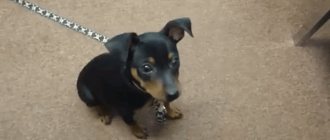Dobermans, along with German shepherds, are one of the best search dogs in the world, used for service in the police, army, and also as guards of private houses and apartments.
Elegant appearance combined with good training abilities make these dogs popular all over the world.
However, those who want to buy a dog of this breed need to understand that the Doberman is a serious service dog and is not suitable as a pet for everyone.
What other features do Dobermans have and what else do future owners of these dogs need to know about them?
Brief description of the breed and what it looks like
Dobermans are large working dogs with short hair .
Thanks to their elegant, but at the same time, muscular physique and fairly strong bones, they give the impression of elegant, strong and hardy animals.
At the same time, the external beauty of these dogs is ideally combined with excellent working qualities.
The body format is square, the physique is lean but muscular . The head is wedge-shaped with a blurred transition to the muzzle. The ears are set high, and in Russia it is usually customary to crop them.
The nose can be black or brown. The eyes are dark, oval, medium in size. The neck is muscular but elegant. The back is short and strong. The chest is deep, but not too wide. Belly tucked.
The tail is set high and usually docked.
Currently, undocked ears and tails .
Characteristics of thoroughbred traits
Dogs of this breed are distinguished by their medium size, correct body proportions, and graceful movements. Adult specimens are distinguished by wide bones and developed muscles. According to the approved world standard, adult individuals must have the following parameters:
- The male reaches a height of 69 - 73 cm at the withers, maximum weight up to forty-four kilograms.
- The female reaches a height of 69 cm at the withers, and her weight ranges from 34 to 35 kilograms.
The size of the skull is medium-sized, with an elongated narrow muzzle.
The frontal bone is undeveloped. High-set ears and a long tail must be docked at a young age. The coat is without undercoat and lies close to the skin. The lack of undercoat makes it impossible to keep dogs in enclosures or outside in winter. The color is predominantly black with red tan markings on the face, collarbone area, and paws.
Origin story
These dogs owe their appearance to a tax collector who lived in Germany in the second half of the 19th century, whose name was Friedrich Louis Dobermann.
Due to his line of work, he often had to transport large sums of money and therefore he needed reliable security.
Therefore, Doberman decided to breed a new breed of service dogs, which will be distinguished by such qualities as intelligence, fearlessness, loyalty and good trainability.
Presumably, the German Pinscher, Rottweiler, Beauceron and Weimaraner participated in the development of the new breed. It is known for certain that the blood of a Greyhound and Manchester Terrier was also infused.
At first these dogs were called Thuringian Pinschers . But after the breed's creator died in 1894, they were named Doberman Pinschers in honor of the man who became their first breeder.
Already by the beginning of the 20th century, Dobermans were widely used in the police service as search dogs, until they were supplanted by the more versatile German Shepherds.
Interesting facts about the Doberman
- During the Second World War, dogs of this breed served in the United States as orderlies, sappers, and on guard duty.
- There are two monuments dedicated to Dobermans. The first is located in Dobermann's homeland, in the town of Apolda. The second monument is located on the island of Guam, where Dobermanns took part in the liberation in 1944. There are 25 dogs carved on the monument that died in this war.
- The Doberman named Sauer is recognized as the best bloodhound in the world. He was able to track a thief by scent over a distance of more than 150 kilometers in South Africa.
- The most famous Doberman in Russia was named Jim. It belonged to actor Vasily Kachalov.
If you decide to get a dog, then get ready for the following: you will often have to clean up little mistakes after your puppy; investments will be required in annual vaccinations, feeding, toys, ammunition, etc.; any animal requires attention and communication, so if you don’t have time, then there will be no mutual understanding with your Doberman puppy. Big changes are coming in your life. If you can handle this, you will find a loyal friend for life. Character of the Doberman: who is better to take a bitch or a dog
Doberman The character of a dog depends on heredity and breed characteristics, but proper upbringing and training is also of no small importance. In the article... Read more
Doberman color
Doberman Color is a canine term that refers to the color of a dog's coat. It is one of the most important traits in breeding... Read more
Training and education of the Doberman
Doberman Raising a dog is about developing correct behavior. This is the basis for successful training. Training is a set of activities aimed at… Read more
Doberman diseases
Doberman Each breed of dog has a predisposition to certain diseases. We have collected information about typical diseases of the breed. Remember the symptoms of the disease, the risk... Read more
How to name a Doberman: a list of nicknames for boys and girls
The Doberman is a bodyguard dog that has high intelligence, courage and a strong bond with its owner. The dog was bred in Germany and ... Read more
Doberman
Character traits
Dobermans are wonderful working dogs that make excellent guards and bodyguards. They are distinguished by their devotion to their owner, intelligence and intelligence.
Possessing a fairly excitable disposition, these dogs are very emotional and tend to react sharply to their environment . The Doberman is always ready to go on the attack at any moment and pounce on the intruder.
But a sharp mind, quick wit and the ability to distinguish a work situation from an everyday one allow these dogs to restrain their aggression and not show it unreasonably.
A well-trained and properly socialized Doberman is friendly and affectionate towards its owners..
These Dobermans get along well with children and other pets and are quite peaceful towards strangers.
Expert opinion
Kozhevin Semyon Kirillovich
Expert dog handler.
“They are strong, intelligent and alert service dogs and are quite large in size. Moderately aggressive, sensitive and emotional, they are rightfully considered one of the best wanted breeds. Dobermans are smart enough to understand when aggression is appropriate, and if such a dog has been raised correctly, there will be no problems with its increased viciousness. A well-trained Doberman is distinguished by enviable endurance and balance. If you don’t devote time to raising such a pet and walking with it, this can lead to the dog starting to misbehave in the house.”
Dobermans in the family
Overall, these dogs are very versatile and can adapt to a wide variety of situations. Their intelligence and how attuned they are to people helps with this. By nature, Doberman Pinschers are pack animals and love the feeling of belonging to a family or group.
You will find that any Doberman you own will quickly become attached to your family and they don't like to be away from the group.
In fact, the Doberman loves the feeling of being with the pack so much that it is often possible to walk them off-leash on a regular basis. Of course, this depends on the training the dog receives and its environment.
If well socialized from an early age, Dobermans are also excellent with children, can work well with many other pets, will be protective of the family, and make an excellent loyal companion.
Advantages and disadvantages
pros:
- Elegant and beautiful.
- Excellent guard or detection dogs.
- Can be trained in any of the dog sports disciplines.
- They are devoted to their master: for his sake they are capable, if not of everything, then of a lot.
- One of the smartest dog breeds.
- They train well.
- Strong and resilient.
Minuses:
- The dog is not for everyone: the Doberman needs a real leader as an owner.
- Dobermans have their own opinion on everything, which is why sometimes the dog can be stubborn and wayward.
- They need a lot of physical activity and training.
- They can be overly angry and cocky.
CAREFULLY!
Dobermans, left alone, can howl out of boredom and also chew furniture and walls.
In order to avoid this problem, you need to walk your dog for a long time and systematically train it.
Buying a Doberman puppy: advice from breeders
Before choosing a Doberman puppy, listen to the advice of experienced breeders who will help you purchase a good, healthy dog.
To buy a Doberman, it is best to visit the nursery yourself and choose a puppy, even if you have a long trip ahead - this will allow you to get to know the breeder with your own eyes, talk to him, look at the mother (and if you’re lucky, then at the father), and in what conditions it is kept litter. Naturally, you must make an appointment with him in advance, because breeders are busy people and have to accommodate a lot of people.
When you arrive, take a good look around. Not every breeder has a model kennel with wire mesh enclosures, but it should be spotlessly clean. If the kennels and walks are dirty, and the area and house look unkempt, it is better to look for a dog elsewhere, no matter how attractive the puppies look.
To keep puppies healthy, they should be kept in a warm, dry, fenced area, lined with clean paper, and kept clean at all times. The bed, covered with a blanket or rags, should also be clean. Puppies raised in such conditions are easier to teach to keep the nest clean and to settle in the right place, that is, outside it. You should not contact breeders who keep puppies unattended in dirty paddocks in which the remains of half-eaten, decaying food and feces are scattered. Surely such puppies are infected with worms, or even something worse, and instead of caring for and caring for your new pet, you will only get a headache.
A responsible breeder will ask a lot of questions about your family and the conditions in which the dog will be kept. He is interested in the question: “Is your yard fenced?” - far from being out of idle curiosity: he may not sell you a puppy until you create safe living conditions for him, because a breeder who has sold his pet does not want to hear a few weeks later that the dog was hit by a car.
Do not go to breeders who try to sell a puppy at five weeks of age without cropping and installing its ears. Most likely, he wants to save money on this and shift all the costs onto you. In addition, a beginner is not mentally prepared for this - ears should be cropped by a specialist, not an amateur.
At what age should you get a Doberman puppy so that the dog quickly adapts to new conditions? A puppy should be purchased no earlier than nine weeks of age, because it is up to this age that anthelmintic prophylaxis and primary vaccination against highly contagious diseases are carried out. His coat should be clean, shiny, his skin should be slightly loose, as if to grow, his eyes should be clear and attentive, without accumulation of mucus and dirt in the inner corners. The puppy should look well-groomed and happy, spreading the smell of cleanliness and childhood.
As you can see in the photo, Doberman puppies are dense and well-fed:
A normal healthy six-week-old puppy weighs on average 4-5.5 kg, and a nine-week-old puppy weighs from 8 kg (females) to 9 kg (males). Lower scores generally indicate poor care. There have been cases when seven-week-old puppies weighed only 2 kg!
If you need a puppy to participate in shows, it is better to rely on the breeder and ask him to choose one for you. Raising a litter, he knows the potential of each of his pets, its positive and negative sides, he can easily determine not only that one of them will have the proper exterior, but also something without which there is no show dog. Ask him to show you the puppy's pedigree and provide explanations along the way - you should learn as much as possible about his origins. Each dog listed in the pedigree has its own story, known to the breeder; he can describe to you in vivid colors what each of them looked like and tell you a lot of interesting things. You, as a beginner, see in the pedigree only a bare sheet of paper with a list of nicknames that mean nothing to you. If possible, try to see the puppy's parents, ask about the achievements of the mother and father in the show ring, as well as about the careers of their offspring.
If you want to talk to a breeder about purchasing a puppy by mail or by long-distance telephone, first find out everything about him from other breeders and owners: what his reputation is, what kind of dogs he has bred in the past and what their temperament is. Don't buy into promising advertising or assurances that the puppy will certainly grow up to be a BIS winner. A self-respecting, honest breeder will never say such a thing. He can only confirm that at the time of sale the puppy is in good condition and has no serious defects or shortcomings, and that its parents have the title of Champion or are truly outstanding young dogs. He or she may be able to provide you with veterinary documentation confirming the puppy's health and that it was sent to you in good condition. The breeder will definitely emphasize the importance of proper diet, exercise and training for the proper development of the puppy. For individual development and revelation of your pet’s personality, he will advise you to communicate with him as much as possible, go for walks, visit unfamiliar places, so that he adapts faster and more easily endures all the hardships of the daily routine of life. And only then can you dream and pray that he becomes a champion.
When you contact a breeder who doesn't currently have a litter, find out if they have plans to breed their dogs in the near future, and if not, if they can recommend anyone who has puppies of the same bloodline. He can offer you a breeder who is not very famous, but has a really good champion bitch. These puppies are often born in the kitchen or living room and receive the best possible care. They are accustomed to children, to the noises and sounds that reign in their home, and, as a rule, are the most socialized. It happens that the breeder who recommended this litter to you planned the mating himself and helped its owner in every possible way with his advice. It is possible that he will help you choose a puppy from him.
Regardless of where you purchased your pet, you should be given at least a four-generation pedigree with it, as well as a blue AKC form to register it. If the breeder has previously registered the puppy in his name (in order to retain the name of the kennel, nickname or prefix), he is obliged to provide you with a correctly executed, white AKC registration form certified in your presence (on the back of which the ownership of the puppy is registered in your name, which, after payment of your fee and registration in the club will be registered and certified by the AKC). The seller is obliged to carefully instruct you about the diet, exercise and care of the puppy at the time of purchase and for the future, as well as about caring for the ears, if he has not removed the bandages from them to artificially set them up.
And most importantly, a real breeder is ready to come to your aid at any moment, even if you have not so global, but ordinary everyday problems, he does not let his pet out of his sight all his life and is ready to share with you all the joys and sadness.
Undoubtedly, the Doberman is not suitable for everyone, and most of the people who keep these dogs would have to get themselves a completely different breed. The fact that Dobermanns have the third highest number of AKC registrations scares breeders. Many so-called “puppy mills” offer five-week-old babies at “ridiculous” prices. Needless to say, they pay little, if any, attention to breeding dogs with the right temperament. Not surprisingly, these puppies have many problems and often end up in animal shelters.
At present, America does not need the same tough Dobermans that are bred in Germany. Most Americans prefer dogs that easily adapt to a simple, slow lifestyle, recognizing family friends rather than just one owner. But this does not mean at all that we do not need a vigilant watchman, ready to protect us at any moment. There is nothing worse than a timid or cowardly-aggressive Doberman. But he should not be an idle talker or easily excitable.
As for the stories describing the attack of the Doberman on its owners, most of them are just gossip, and not based on anything. However, more stories like this will continue to arise if we put the breed into the hands of puppy mill owners rather than true breeders who care and worry about it and breed dogs with the proper temperament.
A correctly bred Doberman is a very smart dog, and therefore requires training and discipline, as well as great physical activity. Dobermans do not like isolation and loneliness, therefore they are not suitable for kennel keeping, otherwise they begin to get bored and acquire a lot of bad habits, for example, constantly jumping on the net, barking, etc. This is a breed that needs human society and constant training. Dobers need an owner who understands this and can manage them intelligently.
There is no domestic dog better than a Doberman! He is great with children. However, breeders should be careful not to lose the breed's qualities of alertness and vigilance. Dogs with good working qualities should be bred, because a true Doberman is a universal breed: at the same time an excellent watchdog, security dog and at the same time a loving domestic dog.
The Doberman usually gets along well with dogs of any other breed. Dobermans have an excellent memory and never forget their old friends.
You can mold your Doberman into almost anything you want, and the fact that the dog resembles its owner is true. The owner's nervousness and slight excitability are easily transmitted to his pet. A calm, sociable person usually has a dog that is as balanced and happy as he is. The Doberman cannot be turned into either a spoiled sissy or a brute. He should be raised to be a useful and well-adjusted member of the family.
Color variations
According to the standard, only two colors are considered acceptable for Dobermans: black and tan and brown and tan. At the same time, on the main black or brown background there are tan marks of a rusty-red hue.
In addition to standard colors, Dobermans also have coat colors such as blue and tan or Isabella and tan .
In addition, sometimes white albino Dobermans are born, whose birth is associated with genetic failures.
Nutritional Features
Doberman Pinschers are distinguished by their large size and great physical activity, and therefore require a nutritious and high-quality complete diet..
Considering that these dogs are not picky about food, you can feed them both natural home-cooked food and ready-made industrial food.
When feeding a dog, you should not combine ready-made food and natural products; in addition, the Doberman should not be overfed, as this can lead to gastric volvulus.
Health and major diseases, life expectancy
Like other service dogs, Dobermans are in good health.
But some representatives of this breed may be predisposed to the following diseases:
- Cardiomyopathy.
- Digestive disorder.
- Gastric volvulus.
- Blood clotting disorder (F. von Willebrand-Jurgens syndrome).
- Hypothyroidism.
- Wobbler's syndrome (slipping of the cervical vertebrae).
- Epilepsy.
- Intermittent claudication.
- Fibrous dysplasia.
Some Dobermans, especially the blue and Isabella varieties, may be prone to allergies.
Their average life expectancy .
Education and training
Considering the rather obstinate nature of the Doberman, it is necessary to raise a pet of this breed from the first day. At the same time, special attention should be paid to his socialization and establishing correct relationships with all family members.
In addition, you need to clearly define the boundaries of what is permitted and prohibit the puppy from doing everything that he will not be allowed to do when he grows up..
Dobermans should not be undeservedly punished or beaten, as this will only embitter the dog, and may not have the best effect on its psyche.
NOTE!
When training your pet, you need to remember that you can teach it only basic commands on your own, without consulting an experienced dog handler.
But in order to train a Doberman, for example, in protective guard duty, he must undergo a special training course under the guidance of a professional trainer.
Peculiarities of raising representatives of the Doberman breed
Before getting a service breed puppy, you should soberly assess your own strengths and capabilities. Dobermans are distinguished by increased activity, endurance, and unyielding character. These pets are suitable for energetic people who are ready for long walks.
Considering the service qualities of Dobermans, simple walks are not enough to raise a dog with a high level of intelligence. All puppies require not only care, but also constant training. The dog clearly reacts to the owner’s manifestation of weakness, which undermines his authority. After the dog senses weakness, he uses it for his own interests. Do not show weakness of spirit around this pet.
Dobermans are cunning and perfectly remember people and situations. In order for your pet to listen and follow all your commands, you must become the “leader of the pack.” A Doberman in the hands of a weak-willed owner can become a source of danger for the surrounding household.
Puppy training should begin in the first months of the dog’s life. Dobermans easily learn new knowledge. There is no need to further anger the dog; genetically endowed qualities imply innate anger. Finally, it is worth noting that representatives of this breed have a hard time with a change of owner.
Features of care
Doberman Pinschers require minimal grooming. Once a week they need to be brushed with a brush for short-haired dogs, and during the shedding period this will have to be done a little more often: 2-3 times a week.
These dogs should be bathed no more often than once every 4-5 months, using special shampoos for animals.
Eyes, ears and teeth should be examined daily and, if signs of contamination appear, promptly cleaned. Dobermans rarely have their nails trimmed, since these dogs usually walk a lot on hard surfaces and grind them down themselves.
We must not forget that the Doberman needs timely deworming and vaccinations; it is also necessary to treat the dog with a flea and tick remedy for preventative purposes..
Exercise requirements
One of the most important aspects when deciding whether a Doberman is right for your family is to consider how active your family is. These dogs need a lot of exercise to keep them happy and relieve stress.
If your family is constantly walking or biking, hiking, or just running around playing outdoor games, then this would be a great dog for you. In fact, you may find that your Doberman will outplay your children and tire them out. If your family is less active and stays at home a lot, this may not be the best choice.
There are many dog breeds that are bred as companion dogs and they will be completely happy to spend hours relaxing on your lap in the house. The Doberman Pinscher is not one of them.
How to feed?
If the owner chooses a natural type of feeding for his pet, the dog’s diet should be based on protein products of animal origin, for example, meat or offal.
IMPORTANT!
The amount of meat or meat products in the Doberman's diet should be at least 30%, and for working dogs it will require approximately 50%.
To the meat you need to add a little porridge from buckwheat, rice or oatmeal, as well as raw or fresh vegetables. It is also useful to add finely chopped greens and vitamin and mineral supplements to food.
If the Doberman eats ready-made industrial food, then it must be high quality food: premium class or higher . At the same time, it must correspond to the pet’s age, size and state of health.
Breeding
Doberman Pins are allowed for breeding if they have good show scores and are not carriers of defects or genetic diseases.
It is unacceptable to breed a bitch in her first heat: you need to at least wait until the second heat, which usually happens every year and a half.
Dobermans are bred on the 10-14th day of estrus. In this case, it is advisable to carry out the mating on the territory of the male dog, where he feels more confident.
After the main mating, a control mating should be carried out 24-48 hours later..
Pregnancy in Dobermans usually lasts 61-63 days, but birth can occur a little earlier or a little later.
A Doberman female gives birth easily and usually has many puppies , on average from 5 to 8, but there are also more numerous litters .
Popular nicknames for boys and girls
Boys : Adrian, Ares, Baron, Viscount, Gray, Demon, Duke, Chris, Lord, Max, Nick, Oscar, Prince, Ray, Steve, Theodore, Fred, Sheriff, Ace, Eugene.
Girls : Iris, Bagheera, Vesta, Grace, Gemma, Zena, Iris, Christa, Lady, Martha, Mabel, Nikta, Parma, Rachel, Stella, Tess, Ursula, Frida, Sherry, Elsa, Utah, Jasper.
It is believed that the most suitable nicknames for Dobermans are those of European, especially German, origin..
How to choose a puppy?
It is recommended to purchase a puppy of this breed from a nursery or from a private breeder. At the same time, a small Doberman must have documents of origin and a veterinary passport.
When choosing a baby, you need to pay attention to his appearance.
A healthy Doberman is active and energetic and has a shiny coat without bald spots. The puppy should not look too fat or thin, and its eyes, nose, ears and skin should be clean and healthy.
If the puppy's ears were cropped, the cut sites should already be completely healed by the time of sale..
Estrus and mating
Full maturation of the bitch occurs at the age of one and a half years. It is during this period that the dog is completely ready to reproduce healthy offspring. As for males, they mature by two years.
Only dogs that have breeding value are allowed to breed. It must be confirmed by relevant diplomas.
Note! If the owner does not intend to breed or participate in exhibitions, then it is better not to untie the pet. Boy Dobermans may noticeably deteriorate in character, but girls may develop health problems.
Price range and in which nurseries you can buy
The average cost of Doberman puppies with documents is 30-40 thousand rubles. Pet-class pets cost from 20 to 25 thousand, and show-class puppies are more expensive: their cost can exceed 50 thousand rubles.
Popular nurseries in Russia:
- "Envy me D'Amour"
- "Pride of Russia"
- "A'Donikons"
- "Alkahest"
- "Appel Di Fortuna"
- "Askania"
- "Versailles Manific"
- "Grand Mollys"
- "Pearl of the Black Earth Region"
- "From the Zoosphere"
- "Coppod Oro"
- "Nevsky Cerberus"
- "S'Lihobor"
- "Sant Creal"
- "Santa Julf"
- "Von Arsidorff"
You can find the websites and addresses of these nurseries on the Internet, especially since many of them have pages on social networks where you can find out about expected litters or puppies ready for sale.
Final thoughts
I am often asked for my opinion on Dobermans living in various situations and I can tell you that I have no hesitation in recommending Dobermans for families. They have so many qualities that make them work incredibly well in families and even with small children.
My decision to buy a Doberman for my family was the perfect decision for me. When I leave home, I like to know that my dog is there with my wife and kids.
When we have a big family and it's a big chaotic scene with lots of kids tugging and tugging at our dog, I'm so happy I have a gentle giant.
Do you know which Doberman is best for your family? To find out, read my article Doberman boy or Doberman girl - who is better to get?











